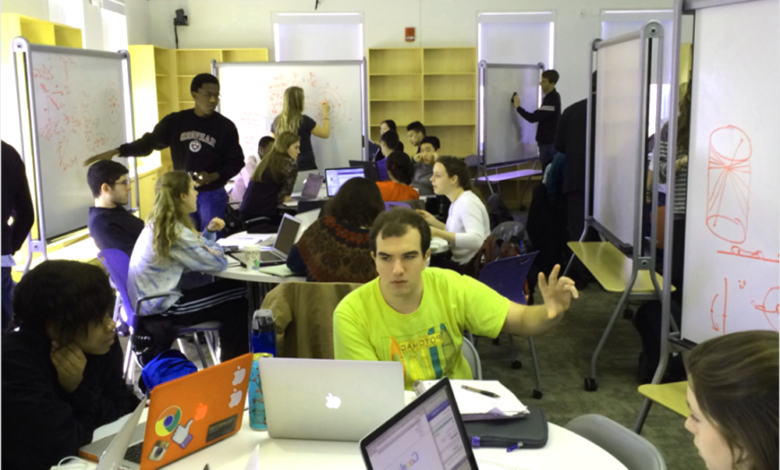From Passive to Active Learning: A Blueprint for Success

In today’s fast-paced world, the traditional approach to learning is evolving. Passive learning, where information is received without active engagement, is gradually being replaced by a more dynamic and effective method active learning. This article delves into the journey from passive to active learning, providing a comprehensive blueprint for success.
From Passive to Active Learning
In the digital era, learning is not just about acquiring information but actively participating in the process. Active learning involves engagement, interaction, and application of knowledge, creating a more profound understanding of the subject matter.
Read More : Key Factors to Consider When Choosing a Managed IT Services Provider
Understanding Passive Learning
Passive learning is characterized by the absorption of information without active involvement. Common methods include lectures, reading, and rote memorization. While these methods have been traditional staples, they often fall short in fostering deep comprehension.

The Pitfalls of Passive Learning
The drawbacks of passive learning are evident, ranging from a lack of engagement to limited retention of information. Learners may find it challenging to stay focused, resulting in a superficial understanding that fades quickly.
Benefits of Active Learning
Active learning, on the other hand, offers enhanced engagement and improved retention. By encouraging participation through discussions, problem-solving, and hands-on activities, learners can develop critical thinking skills and retain information more effectively.
Implementing Active Learning Strategies
To transition from passive to active learning, incorporating interactive workshops, collaborative projects, and real-life applications is crucial. These strategies create an environment where learners actively apply their knowledge, making the learning process more meaningful.
Overcoming Challenges in Transition
Resistance to change is a common hurdle in adopting active learning. However, with adequate support systems and awareness, learners can overcome this resistance and embrace a more participatory and effective learning approach.
Success Stories
Numerous individuals and institutions have successfully embraced active learning, showcasing positive outcomes such as improved academic performance, increased motivation, and enhanced problem-solving skills.
Tools and Technologies for Active Learning
The digital age provides various tools and technologies to facilitate active learning, including interactive software and online platforms. These resources create opportunities for dynamic and engaging learning experiences.
Measuring Success in Active Learning
Evaluation metrics and continuous feedback play a crucial role in measuring the success of active learning. These assessments ensure that learners are not only actively participating but also gaining a deeper understanding of the subject matter.
Tips for Incorporating Active Learning in Various Settings
Whether in a traditional classroom, online course, or workplace training, active learning can be adapted. Practical tips for educators and trainers are provided to make the transition smoother and more effective.
Addressing Common Concerns
Concerns such as time constraints and scalability are addressed, emphasizing that active learning can be tailored to fit different schedules and class sizes.
Future Trends in Active Learning
As technology evolves, so do the trends in active learning. Emerging technologies and evolving educational paradigms are shaping the future of learning, offering exciting possibilities for learners and educators alike.
Read More : Top 7 Best Must-Have Gadgets for 2023
Personal Testimonials
Real-life experiences from individuals who have transitioned from passive to active learning provide a relatable perspective on the challenges and triumphs of this journey.

Expert Opinions
Insights from education professionals shed light on the significance of active learning in the context of modern education, emphasizing its role in preparing learners for the challenges of the future.
Conclusion
In conclusion, the shift from passive to active learning is a transformative journey that brings about numerous benefits. By actively engaging with the learning process, individuals can acquire not only knowledge but also critical skills essential for success in various domains.
FAQs
- Is active learning suitable for all subjects?
- Active learning can be adapted to suit a wide range of subjects, promoting deeper understanding and retention.
- How can educators encourage active participation in online courses?
- Utilizing interactive platforms, discussion forums, and virtual collaboration tools can foster active learning in online settings.
- Are there any age restrictions for implementing active learning strategies?
- Active learning is beneficial for learners of all ages, from early childhood education to professional development.
- What role does technology play in facilitating active learning?
- Technology serves as a catalyst for active learning, providing tools and platforms that enhance engagement and interactivity.
- How can employers integrate active learning into workplace training programs?
- Incorporating hands-on activities, group projects, and simulations can make workplace training more interactive and effective.











